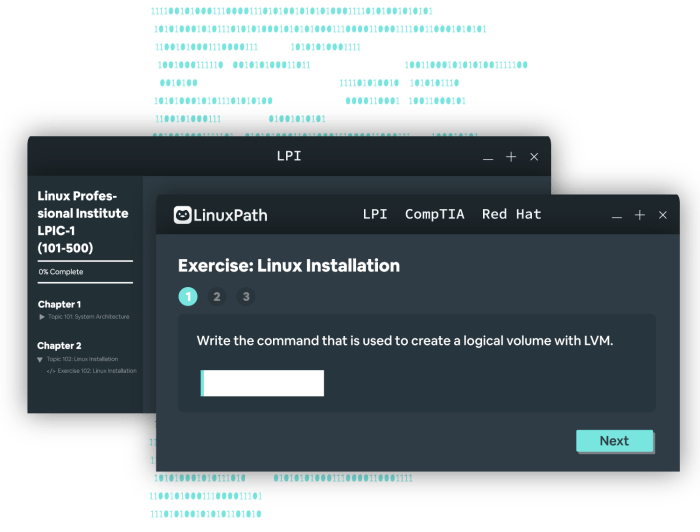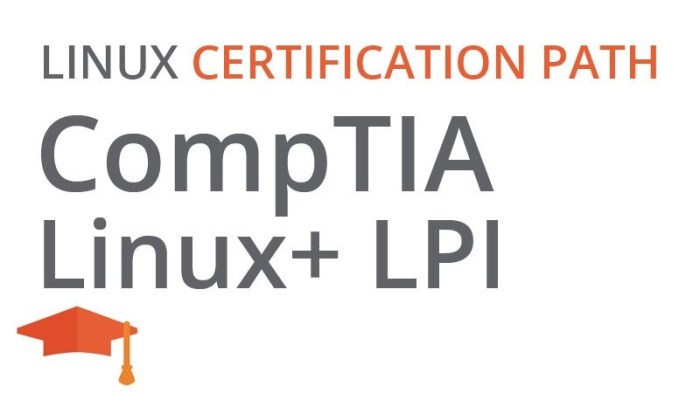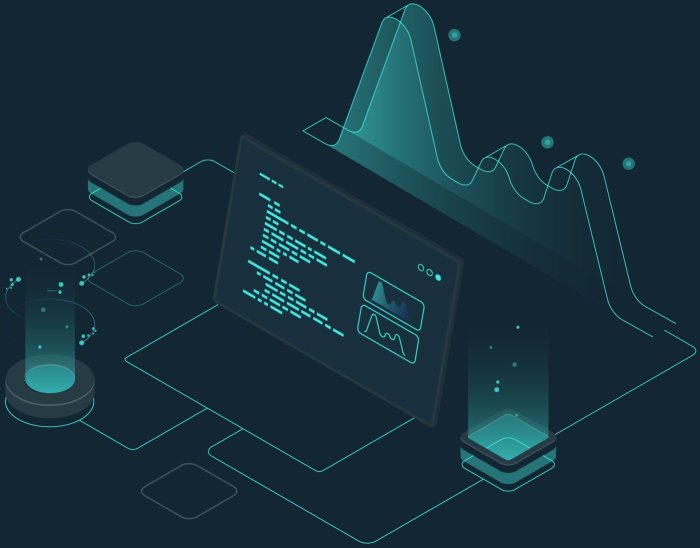Linux+ and lpic-1 gde.to linux certif – In the realm of IT certifications, Linux+ and LPIC-1 stand out as gateways to Linux proficiency. These certifications empower IT professionals with the skills and knowledge to navigate the complexities of the Linux operating system. This comprehensive guide delves into the benefits, exam content, and preparation strategies for both Linux+ and LPIC-1, equipping readers with the insights they need to achieve certification success.
Whether you’re a seasoned Linux user seeking formal recognition or an aspiring IT professional looking to enhance your career prospects, this guide provides a roadmap to Linux mastery.
Linux Foundation Certified IT Associate (LFICA)
The Linux Foundation Certified IT Associate (LFICA) certification validates the foundational knowledge and skills required to perform core system administration tasks in a Linux environment. It is a valuable credential for IT professionals seeking to demonstrate their competence in Linux administration.
Benefits of Obtaining LFICA Certification
Earning the LFICA certification offers several benefits, including:
- Enhanced credibility and recognition in the IT industry
- Validation of Linux administration skills and knowledge
- Increased earning potential and career advancement opportunities
- Improved job security and stability
Exam Objectives and Content
The LFICA exam covers a wide range of topics, including:
- Linux fundamentals
- System administration
- Networking
- Security
- Troubleshooting
Tips for Preparing for and Passing the Exam, Linux+ and lpic-1 gde.to linux certif
To prepare for the LFICA exam effectively, consider the following tips:
- Familiarize yourself with the exam objectives and content.
- Utilize official study materials provided by the Linux Foundation.
- Practice with mock exams and hands-on exercises.
- Join study groups or forums for support and collaboration.
- Stay up-to-date with the latest Linux technologies and trends.
LPIC-1 Exam

The LPIC-1 exam is a certification that validates the knowledge and skills of Linux system administrators. It is offered by the Linux Professional Institute (LPI) and is the first level in the LPIC certification track.The LPIC-1 exam consists of two parts, each of which covers different aspects of Linux system administration.
The first part, 101-500, focuses on system administration tasks, while the second part, 102-500, focuses on Linux troubleshooting and maintenance.The key topics covered in the LPIC-1 exam include:* Linux system architecture
- Installation and configuration of Linux systems
- User and group management
- File system management
- Networking and security
- Troubleshooting and maintenance
To pass the LPIC-1 exam, candidates should have a strong understanding of these topics. They should also be able to apply their knowledge to real-world situations.
Exam Format
The LPIC-1 exam is a multiple-choice exam. Each part of the exam consists of 60 questions. Candidates have 90 minutes to complete each part of the exam.
Skills and Knowledge Required
To pass the LPIC-1 exam, candidates should have the following skills and knowledge:* A strong understanding of Linux system architecture
- Experience in installing and configuring Linux systems
- Experience in managing users and groups
- Experience in managing file systems
- Experience in networking and security
- Experience in troubleshooting and maintaining Linux systems
Linux Certification

Linux certification is a valuable credential that demonstrates your knowledge and skills in Linux operating systems. There are several different Linux certifications available, each with its own focus and level of difficulty.
Choosing the Right Certification Path
The best Linux certification for you depends on your career goals and experience level. If you are new to Linux, you may want to start with a foundational certification, such as the Linux Foundation Certified IT Associate (LFICA). Once you have a solid understanding of Linux fundamentals, you can then move on to more advanced certifications, such as the LPIC-1 or LPIC-2.
Comparison of Different Linux Certifications
The following table compares some of the most popular Linux certifications available:| Certification | Level | Focus | Prerequisites ||—|—|—|—|| Linux Foundation Certified IT Associate (LFICA) | Entry-level | Linux fundamentals | None || LPIC-1 | Intermediate | Linux administration | None || LPIC-2 | Advanced | Linux administration | LPIC-1 || RHCSA | Intermediate | Red Hat Enterprise Linux administration | None || RHCE | Advanced | Red Hat Enterprise Linux administration | RHCSA |
Advantages and Disadvantages of Different Certifications
Each Linux certification has its own advantages and disadvantages. The following table summarizes some of the key advantages and disadvantages of each certification:| Certification | Advantages | Disadvantages ||—|—|—|| Linux Foundation Certified IT Associate (LFICA) | Entry-level certification | Limited scope || LPIC-1 | Vendor-neutral certification | Can be challenging for beginners || LPIC-2 | Advanced certification | Requires LPIC-1 certification || RHCSA | Focuses on Red Hat Enterprise Linux | Can be expensive || RHCE | Advanced certification | Requires RHCSA certification |
Linux Skills: Linux+ And Lpic-1 Gde.to Linux Certif
Linux skills are essential for IT professionals in today’s technology-driven world. With its open-source nature and versatility, Linux has become a dominant operating system in various sectors, including cloud computing, enterprise IT, and embedded systems.
Developing a strong foundation in Linux skills can significantly enhance career prospects and open up new opportunities for IT professionals. Here are some of the essential Linux skills categorized into different areas:
System Administration
- Command-line proficiency: Mastering the command line is crucial for system administration tasks, including user management, file management, and system configuration.
- Package management: Understanding how to install, update, and remove software packages is essential for maintaining a stable and up-to-date Linux system.
- Service management: IT professionals should be proficient in managing system services, such as starting, stopping, and restarting services, as well as troubleshooting service-related issues.
- Disk management: The ability to manage disk partitions, create and mount filesystems, and perform disk-related tasks is vital for system administration.
- System monitoring: Monitoring system resources, such as CPU usage, memory utilization, and disk space, is crucial for identifying and resolving performance issues.
Networking
- Network configuration: IT professionals should be able to configure network interfaces, assign IP addresses, and manage network settings.
- Firewall management: Understanding how to configure and manage firewalls is essential for protecting Linux systems from unauthorized access.
- Routing and switching: Knowledge of routing and switching concepts is important for managing network traffic and ensuring efficient data flow.
- Network troubleshooting: The ability to diagnose and resolve network-related issues is crucial for maintaining network uptime and performance.
Security
- User and group management: IT professionals should be proficient in creating and managing user accounts, assigning permissions, and implementing security measures.
- Access control: Understanding how to control access to files, directories, and system resources is essential for protecting data and system integrity.
- Log management: The ability to analyze system logs and identify security-related events is crucial for detecting and responding to potential threats.
- Security hardening: IT professionals should be able to implement security measures to protect Linux systems from vulnerabilities and attacks.
Linux Distributions

Linux distributions are operating systems built around the Linux kernel. They include a set of software packages and tools that provide a complete operating environment for users.
Choosing a Linux distribution depends on factors such as the intended use, hardware compatibility, user experience, and software availability.
Popular Linux Distributions
The following table summarizes popular Linux distributions:
| Distribution | Features | Strengths | Weaknesses |
|---|---|---|---|
| Ubuntu | User-friendly, wide software selection, strong community support | Ease of use, large user base | Can be resource-intensive |
| Red Hat Enterprise Linux (RHEL) | Stable, secure, certified for enterprise use | Reliability, enterprise support | Costly, less user-friendly than some other distributions |
| CentOS | Community-supported version of RHEL, free and open source | Stability, enterprise-grade features | Less user-friendly than Ubuntu |
| Debian | Stable, secure, package management system | Stability, wide software selection | Can be complex to configure |
| Fedora | Bleeding-edge technology, community-driven | Latest software, cutting-edge features | Can be less stable than other distributions |
Linux Case Studies
Linux has been widely adopted in various industries, leading to numerous successful implementations. These case studies demonstrate the versatility and adaptability of Linux in different scenarios, highlighting the challenges faced and benefits achieved.
Government and Public Sector
- The United States Department of Defense (DoD) has adopted Linux for its Joint Enterprise Defense Infrastructure (JEDI) cloud computing platform, replacing its legacy systems with a modern, open-source solution.
- The United Kingdom’s National Health Service (NHS) has implemented Linux-based systems in over 90% of its hospitals, improving patient care and reducing IT costs.
Education
- The Massachusetts Institute of Technology (MIT) uses Linux as the primary operating system for its academic and research computing infrastructure, providing students and researchers with a reliable and flexible platform.
- The University of California, Berkeley has developed the Berkeley Open Infrastructure for Network Computing (BOINC) platform, which leverages Linux to enable distributed computing for scientific research.
Financial Services
- JPMorgan Chase has migrated its core banking systems to Linux, reducing infrastructure costs by over 50% and improving performance.
- Goldman Sachs has adopted Linux as the foundation for its trading and risk management systems, enhancing security and scalability.
Healthcare
- The Mayo Clinic has implemented Linux-based systems for its patient records, medical imaging, and clinical decision support tools, improving patient safety and operational efficiency.
- CERN, the European Organization for Nuclear Research, uses Linux to manage its massive particle accelerator, the Large Hadron Collider.
Other Industries
- Amazon Web Services (AWS) and Microsoft Azure, two of the leading cloud computing providers, offer Linux-based virtual machines and services, enabling businesses to leverage the benefits of open-source software.
- The automotive industry is increasingly adopting Linux for in-vehicle infotainment systems, providing enhanced connectivity and functionality.
FAQ Explained
What are the benefits of obtaining Linux+ certification?
Linux+ certification validates your skills in Linux administration, networking, and security. It demonstrates your proficiency to potential employers and enhances your credibility in the IT industry.
What topics are covered in the LPIC-1 exam?
The LPIC-1 exam covers a wide range of topics related to Linux administration, including system installation and configuration, user management, file permissions, networking, and troubleshooting.
How can I prepare for the Linux+ and LPIC-1 exams?
To prepare effectively for the Linux+ and LPIC-1 exams, it is recommended to study the official exam objectives, practice with sample questions, and gain hands-on experience with Linux.